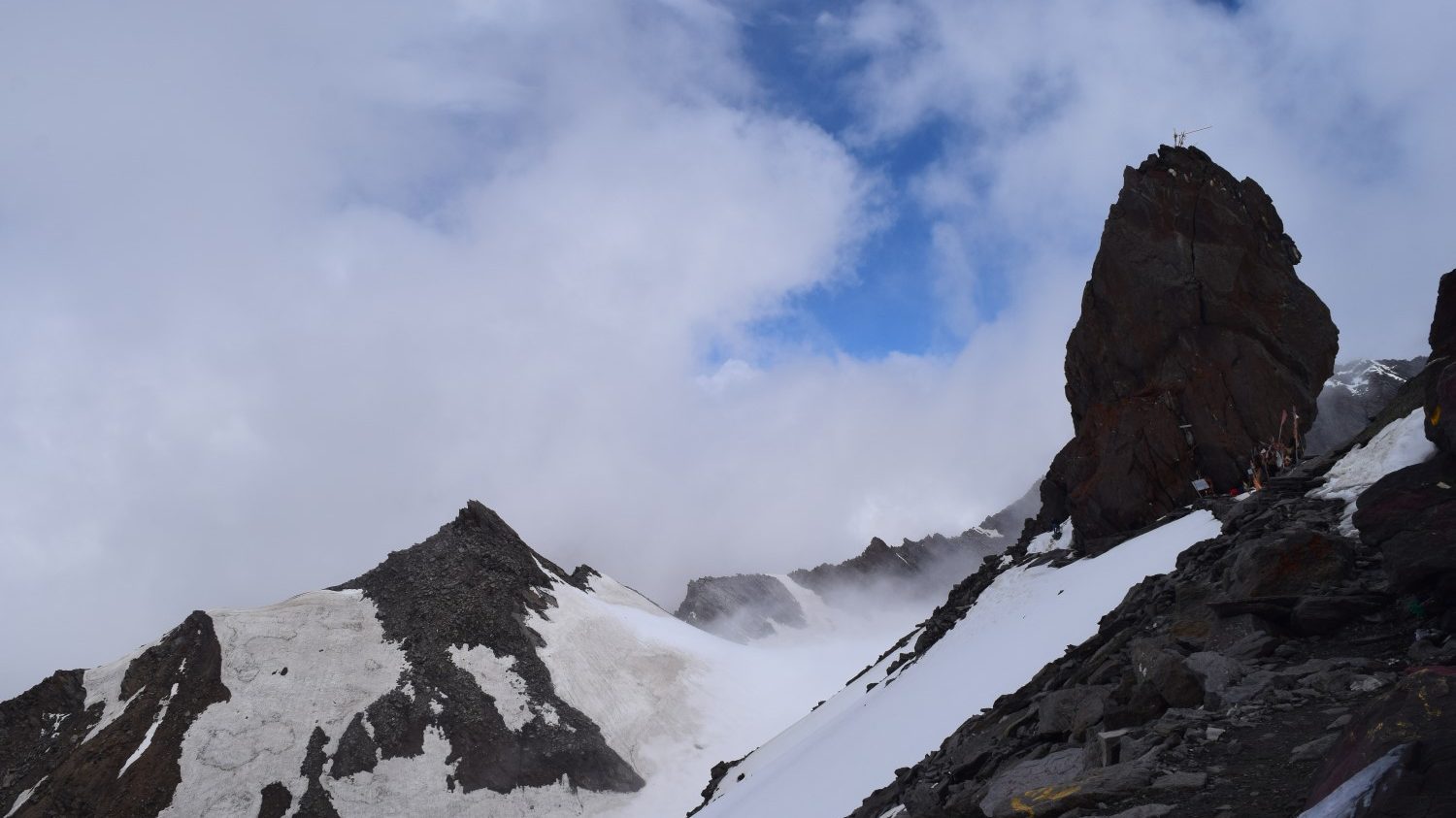Some journeys in life are not just about reaching a destination, but about discovering yourself on the way. The Shrikhand Kailash Yatra is one such pilgrimage. At an altitude of around 16,900 feet, the Shrikhand Kailash peak stands tall in Himachal Pradesh, believed to be one of the abodes of Lord Shiva. Unlike other yatras, this one isn’t just a walk—it’s a test of faith, stamina, and sheer willpower.
If you’ve ever dreamt of walking into the clouds, hearing only the sound of your breath and the wind, and standing in front of a natural rock Shivling surrounded by snow-capped peaks, then Shrikhand Kailash is waiting for you.
I’ll share my journey, the challenges, the little joys along the trail, and everything you need to know before you pack your bag.
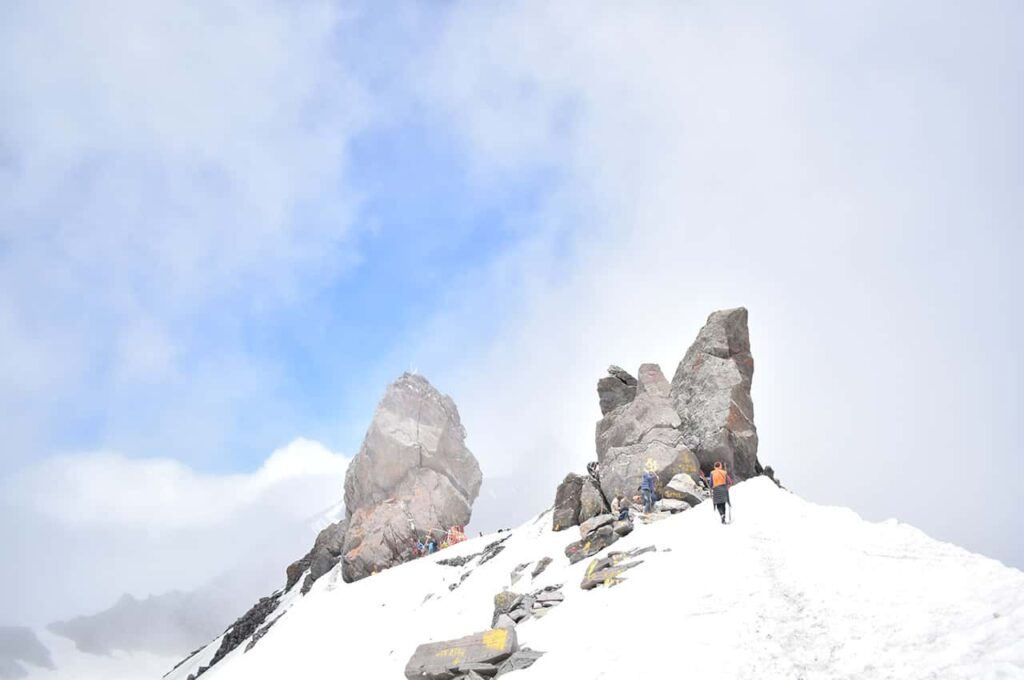
Getting There – The Road to the Base
Your adventure begins at Jaon village in the Kullu district, about 170 km from Shimla. Most yatris arrive here after long, winding drives through the Sutlej valley. Jaon isn’t fancy—it’s a simple Himalayan village with small homestays, a couple of tea shops, and the hum of excited trekkers preparing for the climb.
From Jaon, the trek to Shrikhand Kailash is about 32 km one way. It usually takes 7–8 days for the round trip, depending on your pace and weather conditions.
The Trek Route – Day by Day
When people say Shrikhand Kailash is one of the toughest pilgrimages in India, they’re not exaggerating. Here’s how the trail unfolds:
Day 1: Jaon to Singhad (3 km)
The first stretch is relatively easy. The trail winds through apple orchards and small villages. You’ll meet locals who often greet pilgrims with smiles and sometimes even fresh apples. At Singhad, there are dhabas (small eateries) where you can rest, sip tea, and gather energy for what’s ahead.
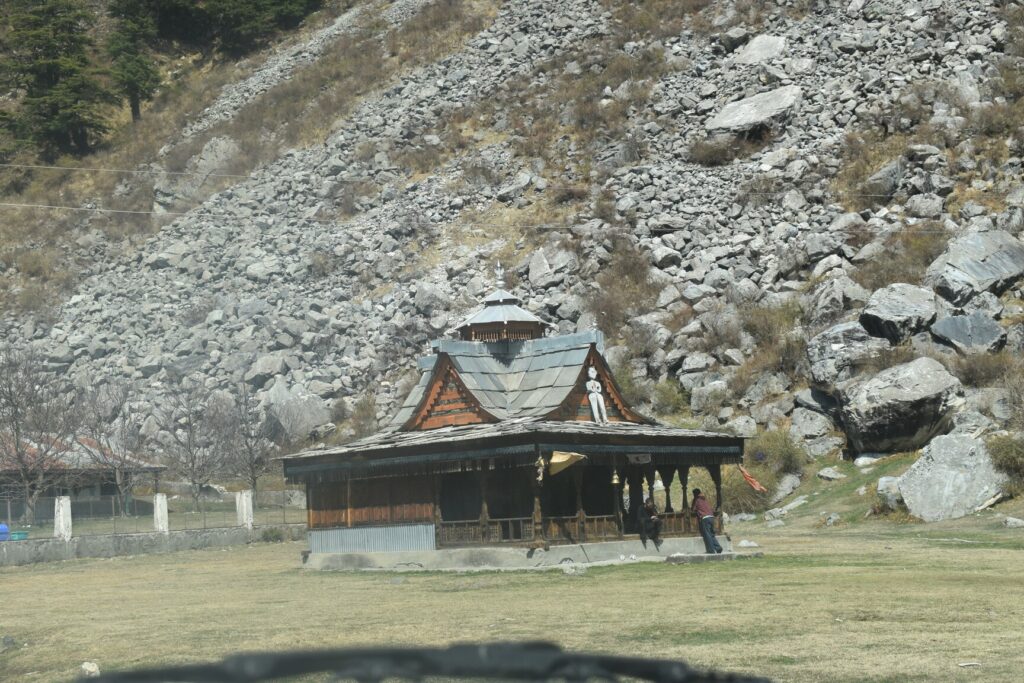
Day 2: Singhad to Thachru (12 km)
This is where the real climb begins. The trail goes straight up through dense forests. It feels endless at times, with steep steps that test your patience. By the time you reach Thachru (around 11,000 ft), you’ll be exhausted but rewarded with your first real views of the higher Himalayas.
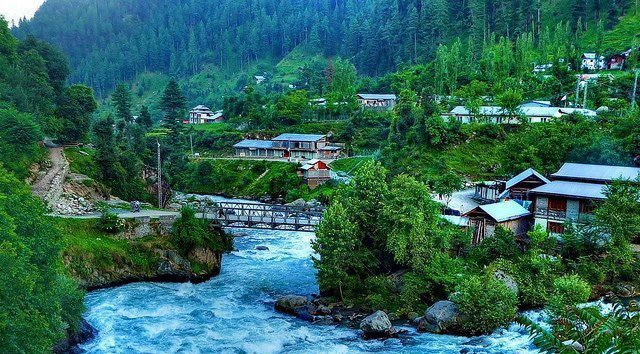
Day 3: Thachru to Kali Ghati to Bhim Talai (10 km)
Crossing Kali Ghati Pass (14,000 ft) is one of the highlights of the trek. The trail becomes rocky, and the weather changes quickly. Mist rolls in, and the wind whistles through the ridges. From here, the descent to Bhim Talai feels easier, but your legs will remind you that nothing is easy on this yatra.
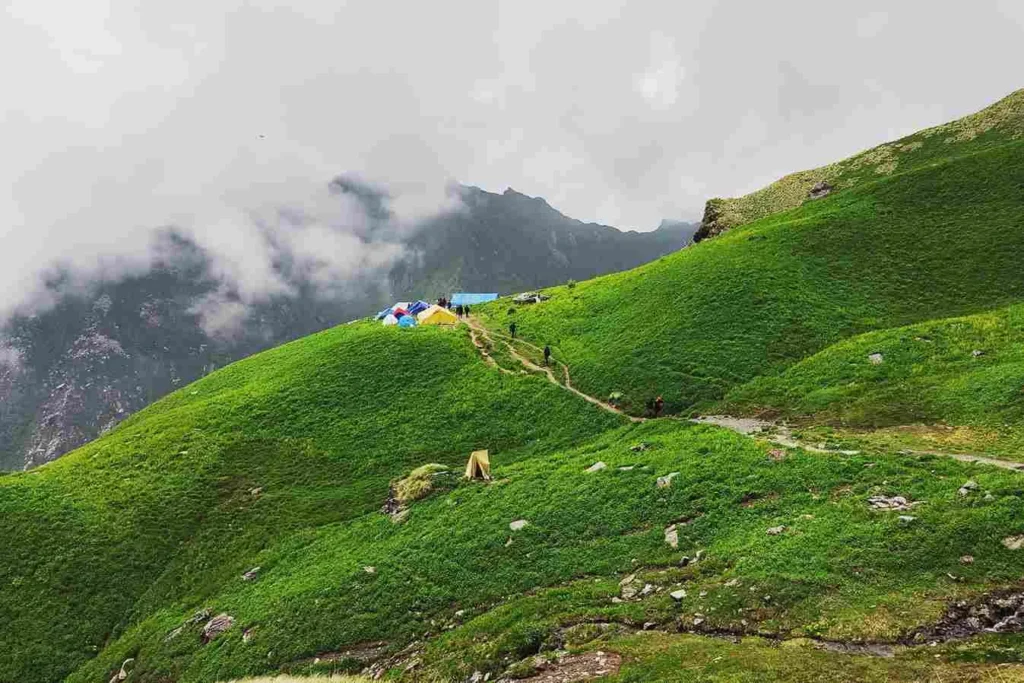
Day 4: Bhim Talai to Nain Sarovar (8 km)
This is one of the most spiritual parts of the trek. The lake, Nain Sarovar, is surrounded by glaciers, and its water is icy cold yet crystal clear. Pilgrims believe bathing here washes away sins. Standing at its edge, with the mountains reflected in the water, you feel humbled.
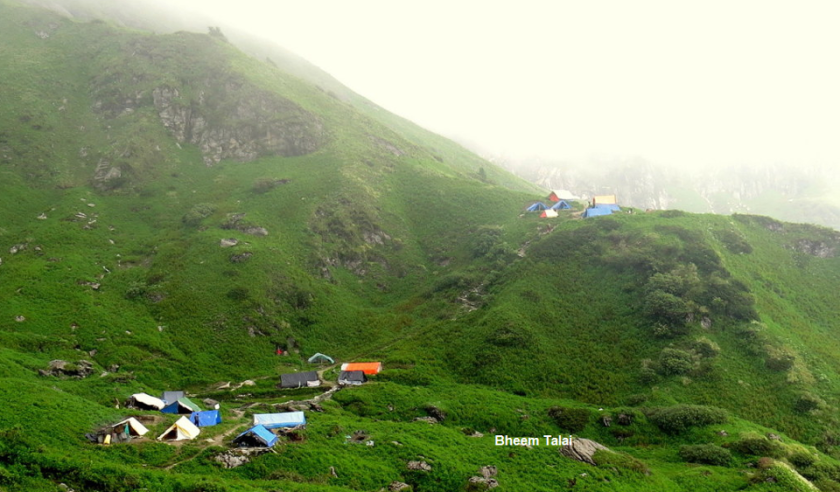
Day 5: Nain Sarovar to Shrikhand Kailash Peak and back (12 km)
This is the big day. The climb is relentless, with rocky paths, snow patches, and thin air making every step an effort. Finally, as you approach the 90-feet tall Shivling-shaped rock, it feels like the mountains themselves are bowing. Many pilgrims cry, some chant “Om Namah Shivaya,” and some just sit in silence.
The return journey retraces the same path, though descending is no less challenging.
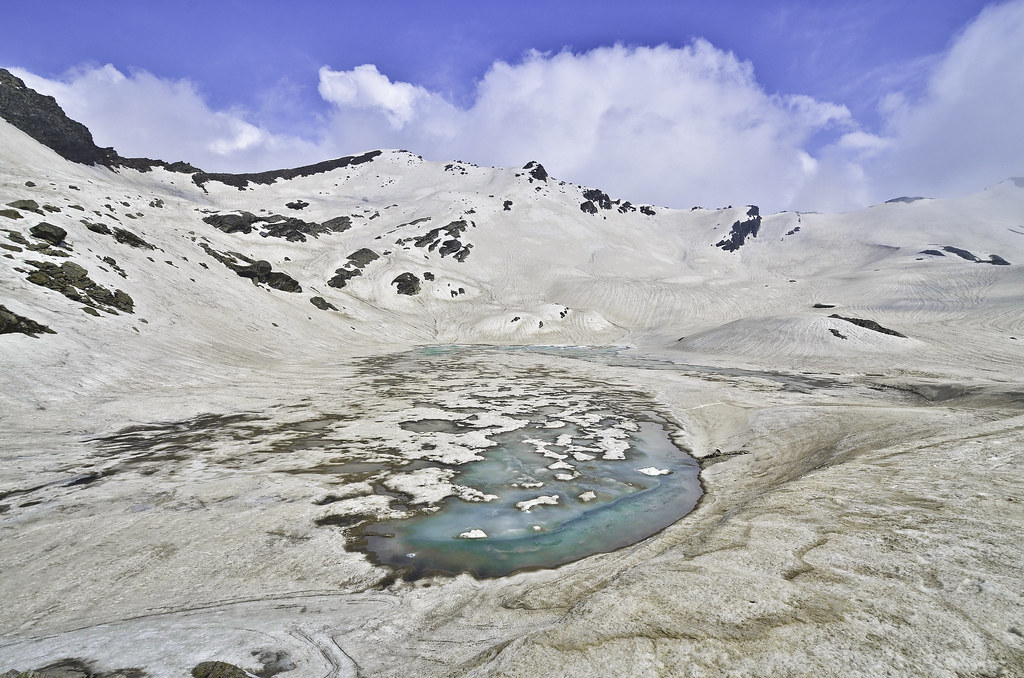
The Challenges – What Makes It Tough
I won’t sugarcoat it—Shrikhand Kailash Yatra isn’t for the faint-hearted. Here’s what you should be prepared for:
- Altitude: At nearly 17,000 ft, oxygen levels drop, and even walking slowly feels like a marathon.
- Steep climbs: There are sections where the trail seems vertical. Your knees will ache, and your lungs will burn.
- Weather: Sunshine, rain, and snowfall—all in a single day. Carrying proper gear is non-negotiable.
- Basic facilities: Camps are set up during the official yatra season, but don’t expect luxury. It’s all about shared tents, basic food, and a lot of patience.
But here’s the thing—every challenge makes the journey more meaningful. The tougher it gets, the more connected you feel to the mountains and to yourself.
Preparing for the Yatra – Tips from the Trail
- Train your body: Start walking or trekking regularly at least a month before. Focus on stamina, not speed.
- Pack wisely: A sturdy backpack, good trekking shoes, layered clothing, raincoat, and walking stick are musts.
- Travel light: Carry only essentials. Every extra kilo feels like ten on the trail.
- Hydrate and eat light: Drink enough water, but avoid overeating while trekking.
- Respect the mountains: Don’t litter. Carry your trash back. The Himalayas deserve to stay pristine.
- Mental strength: More than the body, it’s your mind that will push you forward. There will be moments when you’ll want to quit—but faith and determination will carry you through.
The Spiritual Vibe
Unlike other tourist treks, Shrikhand Kailash is more of a pilgrimage. You’ll walk alongside people of all ages—grandparents chanting “Har Har Mahadev,” youngsters carrying flags, and families supporting each other.
At night, the camps echo with bhajans and prayers. Some light candles, others share stories of their past yatras. Even strangers feel like family here.
And when you finally stand before the Shivling at the top, all the pain, all the sweat, all the sleepless nights—everything feels worth it. It’s not just about seeing the peak; it’s about the inner journey that brought you there.
My Favorite Moments
- The first glimpse of Kali Ghati: Clouds swirling below you, with peaks shining in the distance—it feels surreal.
- Chai at Thachru: A steaming cup of tea after hours of uphill climb tastes better than any luxury café drink.
- Nain Sarovar’s silence: Just sitting by the lake, watching your reflection, makes you realize how small yet blessed we are.
- The final ascent: Every pilgrim cheering each other on, some shouting “Bam Bam Bhole” with teary eyes—it gives you goosebumps.
Night Camps at Shrikhand Kailash – Living Under the Himalayan Sky
One of the most unforgettable parts of the Shrikhand Kailash Yatra isn’t just the climb or even reaching the Shivling at the summit—it’s the experience of spending nights in makeshift camps scattered along the trail. These high-altitude halts turn the yatra into more than just a pilgrimage; they transform it into a shared story of endurance, faith, and community.
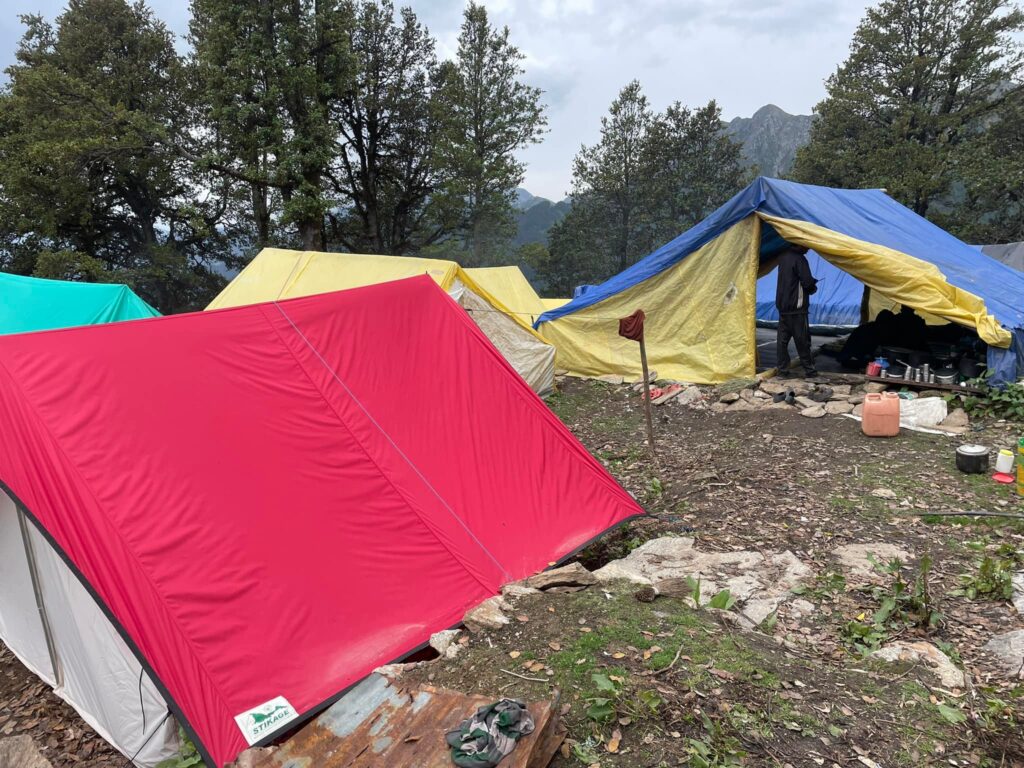
The First Night: Easing Into the Journey
The first night halt usually happens at Singhad, a modest stretch of meadows where pilgrims gather after leaving Jaon village. The atmosphere here feels almost festive. You can still hear distant temple bells from the valley below, and the air is thick with anticipation. Camps here are relatively comfortable, with simple tarpaulin shelters, tents pitched on flat ground, and a handful of dhabas offering warm dal-rice or steaming cups of chai.
It’s the night when you still feel close to civilization, but at the same time, the Himalayas are beginning to take over. Many people spend this night talking about the days ahead, sharing stories from past yatras, or nervously checking their gear. It’s a gentle initiation into the world of mountain camps.
The Higher You Go, the Quieter It Gets
By the time you reach Thachru, the camps take on a very different vibe. At over 11,000 feet, the climb has already tested your stamina, and resting here feels like a reward. Tents are fewer, the cold is sharper, and the sound of mobile ringtones is gone. In its place, you hear the wind whistling through forests and the occasional laugh of a pilgrim trying to keep spirits high.
What makes camps at these altitudes unique is the absence of distractions. Without internet or electricity, evenings become all about human connection. Pilgrims huddle together, sip soup from steel bowls, and share both food and stories. Strangers bond quickly when they’re walking the same path, facing the same challenges.
Food at the Camps – Simple but Soulful
Don’t expect restaurant menus at Shrikhand Kailash camps. Here, food is about survival, warmth, and gratitude. Community kitchens (langars) set up by volunteers often serve khichdi, dal, chapati, or tea. Sometimes, the meal is as basic as boiled potatoes with salt—but after hours of climbing, it feels like a feast.
One of my strongest memories is sipping hot ginger tea at Kali Ghati, my hands numb from the cold. The tea wasn’t fancy, but the steam rising from the cup against the backdrop of misty peaks felt magical. Pilgrims often describe this kind of food as “prasad,” a blessing that gives not just energy but also comfort.
Nights Filled with Prayer and Song
As dusk falls, the atmosphere around the camps changes. Fires are lit, and you’ll often hear pilgrims chanting “Om Namah Shivaya” or singing bhajans in small groups. The sound isn’t organized or rehearsed—it comes from the heart, echoing across valleys.
Sometimes, someone pulls out a dhol or a conch, and soon, the entire camp is alive with rhythm and devotion. Sitting around a fire, under the stars, surrounded by mountains—it’s a kind of temple without walls. Even those who aren’t deeply religious find themselves moved by the sincerity in the air.
Cold, Stars, and Long Silences
Once the singing fades and the fires die down, the true Himalayan night reveals itself. The temperature drops drastically—sometimes below freezing, even in July. Inside the tents, people curl into sleeping bags, layering blankets and jackets, trying to trap every bit of warmth.
Step outside for a moment, though, and you’re rewarded with skies you’ll never forget. The Milky Way arcs across the heavens, and shooting stars streak silently above the peaks. In the stillness, every whisper carries. The silence can feel heavy at first, but soon it becomes comforting, as though the mountains themselves are keeping watch.
Struggles of the Camps
It would be dishonest to romanticize these nights completely. Life in the camps is tough. The ground is uneven, the tents can feel cramped, and the cold creeps into your bones. Many people struggle to sleep well. Some fight headaches from the altitude, while others wake up shivering.
Yet, these struggles become part of the story. Sharing a cramped tent with strangers, laughing at the absurdity of it all, or passing around an extra blanket—these moments remind you that comfort isn’t always necessary for joy.
Camaraderie Among Pilgrims
One of the most beautiful aspects of the night camps is the way people come together. A young trekker might help an elderly pilgrim tie shoelaces; a stranger might offer you part of their meal when your energy dips; someone might tell you a joke just when the climb feels unbearable.
At night, when everyone rests, these bonds become stronger. You may find yourself lying awake, listening to someone snoring in the next tent, and realizing you feel oddly safe—protected not just by the peaks but by the community that surrounds you.
The Camp Before Nain Sarovar
Among all the halts, the camp near Nain Sarovar has the most surreal atmosphere. The lake itself holds deep spiritual significance, and spending a night so close to it feels extraordinary. Pilgrims light small diyas (lamps) near the water or simply sit quietly, watching the reflection of stars ripple on the surface.
The cold here is biting, the wind harsher, but the silence carries a depth you won’t experience anywhere else. Many say this is the night when the inner journey feels most profound.
Why These Nights Stay With You
Long after you return from the yatra, what lingers in memory isn’t just the view of the Shivling at the summit, but the collective warmth of these nights. The shared meals, the chants that drifted into the darkness, the way the stars looked impossibly close—it all leaves an imprint that feels timeless.
It’s strange how the simplest things—like a blanket passed by a stranger or a cup of chai offered in the cold—become the most powerful memories. In the camps, life strips down to essentials: food, warmth, companionship, and faith. That simplicity is what makes the nights so meaningful.
When to Go for Shrikhand Kailash Yatra – A Season-by-Season Guide
Planning a journey to Shrikhand Kailash is not like planning a weekend trek. This yatra demands preparation, faith, and timing. The mountain sits at nearly 16,900 feet, and the trail to the Shivling rock formation remains snow-covered for much of the year. Picking the right season can make the difference between a memorable pilgrimage and an unsafe gamble.
Let’s walk through the year and see what each season brings for anyone considering this sacred journey.
Winter (November to March) – The Land of Snow and Silence
During winter, Shrikhand Kailash is buried deep under snow. Temperatures plummet well below freezing, often dropping to -10°C or lower at higher altitudes. Trails vanish beneath layers of ice, and even local shepherds and villagers avoid the upper regions.
- Trail Condition: Completely inaccessible. Heavy snowfall blocks paths, and avalanches are a serious risk.
- Camps: All seasonal shelters are shut down. Even hardy locals don’t attempt to go beyond Jaon or Singhad.
- Experience: The mountains look majestic, covered in white, but they are hostile. Nights are long, days are short, and storms sweep across the ridges.
- Verdict: Not suitable for yatris or trekkers. Even experienced mountaineers avoid this period.
If you visit Himachal in winter, admire the Sutlej valley or explore nearby villages, but forget about climbing Shrikhand Kailash.
Spring (April to May) – The Tempting Yet Deceptive Window
As spring arrives, apple orchards bloom in the valleys, and the lower stretches of the trail become inviting again. The air smells fresh, and snow begins to melt at lower altitudes. This is when many adventurous trekkers get curious—but the higher reaches still remain treacherous.
- Trail Condition: From Jaon to Thachru, paths start clearing. Beyond Kali Ghati, snowfields remain thick, making navigation extremely risky.
- Camps: Temporary camps are not yet operational. Anyone attempting the trail must carry their own tents and food.
- Experience: The contrast is striking—green meadows at the base, but blinding snow higher up. Water sources are icy, and the terrain is unpredictable.
- Verdict: Not recommended for pilgrims. Spring offers beauty but not safety. Only seasoned trekkers with proper gear should attempt partial climbs.
For most devotees, it’s wiser to wait a couple more months.
Summer (June to August) – The Official Yatra Season
This is when Shrikhand Kailash opens its doors. The Shrikhand Mahadev Yatra is officially organized by the Himachal Pradesh government, usually in July and August. Camps, medical posts, and langars (community kitchens) are set up along the trail, and thousands of pilgrims make their way to the Shivling.
- Trail Condition: By late June, snow clears from most paths, though patches remain near Nain Sarovar and the summit. The trail is tough—steep ascents, rocky ridges, and narrow passages—but navigable.
- Camps: Fully functional during this time. You’ll find tents at Singhad, Thachru, Kali Ghati, Bhim Talai, and Nain Sarovar. Food, blankets, and basic medical support are available.
- Experience: This is when the trail comes alive. Devotional chants echo across valleys, pilgrims of all ages walk together, and the atmosphere feels like a moving temple. Days are warm but not hot, while nights are cold but bearable. Rain is common, so ponchos and waterproof gear are essential.
- Verdict: The best and safest time to undertake the Shrikhand Kailash Yatra. The infrastructure, community support, and relatively stable weather make it possible for thousands to complete the pilgrimage.
If you want the full spiritual and cultural experience, July–August is the window to mark on your calendar.
Autumn (September to October) – The Afterglow of Yatra
Once the official season ends, the camps pack up, and the crowd disappears. By September, the weather shifts again. Skies remain clear for a few weeks, but nights grow harsher, and snow slowly starts reclaiming the higher sections.
- Trail Condition: Paths remain open in early September but begin to ice up later in the month. By October, snow makes sections like Kali Ghati and Nain Sarovar difficult to cross.
- Camps: No organized support after the official yatra ends. Trekkers must be self-sufficient.
- Experience: The mountains feel quieter, more solitary. Without large groups, you can soak in the silence, but the risk factor is higher. Nights dip below freezing, and storms arrive suddenly.
- Verdict: Possible in early September for experienced trekkers, but not advised for general pilgrims. By mid-October, conditions resemble early winter.
If you want solitude and are ready for self-reliance, early autumn offers raw beauty. For most yatris, though, it’s past the safe window.
Choosing the Right Time – A Pilgrim’s Perspective
If your purpose is devotion and darshan, stick to the official yatra season. The infrastructure exists then for a reason—it ensures safety, guidance, and medical help. The collective energy of thousands chanting together also enhances the spiritual experience.
If your purpose is adventure and trekking, early September can be tempting for quieter trails and clearer skies. But you need to be well-prepared, both physically and logistically.
Any attempt outside June–August is more an expedition than a yatra. It requires technical gear, survival planning, and a high tolerance for uncertainty. For most pilgrims, that defeats the essence of Shrikhand Kailash, which is about faith, not extreme risk.
Things You Should Know
- Network: Don’t expect mobile connectivity beyond Jaon. Consider it a digital detox.
- Food: Simple meals like dal, rice, chapati, and tea are available at camps. Carry dry fruits or energy bars for quick boosts.
- Guides and porters: If you’re not confident about trekking solo, hire a local guide. They know the terrain like the back of their hand.
- Permit: During the official yatra, registration is mandatory for safety.
Why Shrikhand Kailash is Worth It
So, is the Shrikhand Kailash Yatra worth all this struggle? A thousand times yes. It’s not just about reaching a mountain peak—it’s about the transformation along the way. You learn patience, you push your limits, and you experience a deep sense of connection with nature and the divine.
Every pilgrim I met had a story—some came to fulfill a vow, others to find peace, and a few just to challenge themselves. But all left with one common feeling: gratitude.

